Zion Covenant Church moves forward in its pursuit of Congregational Vitality
By Leslee Hugare, Member of Zion Covenant Church
Ellsworth, WI—comfortably situated in western Wisconsin—is a township of 3,500 people, one stop light, one McDonald’s, a strong tradition of state wrestling championships, multiple bars (with great food) and the best cheese curds in the land! On the surface, it may appear that Ellsworth is a community comfortable with its current pace and offerings; and for some that may be true. However, if you drive just north of downtown Main Street, you will find a group of missional people, passionately pursuing Christ and His priorities in the world.
Zion Covenant Church has a rich history that has afforded us the joy of celebrating 125 years of ministry as we seek to be obedient to who God has called us to be. And in the midst of what, for some, have been painful transitions of letting go, God has been present and has poured blessings on us.
Vitality journey
Eight years ago, Zion recognized that if we were to be relevant and present for the next generation, change would need to occur. Therefore, we began the Vitality Pathway in partnership with the Northwest Conference and the Evangelical Covenant Church. Through this process, Zion went from a church identified as “Critical Moment” moving toward “At Risk,” to now a “Stable” moving toward “Missional” church. This shift did not happen overnight. It took much prayer, commitment and courage. Throughout Scripture we see God asking His people to take bold, faithful steps in order to lead His people to a new place of growth and life. Zion has seen this growth and new life through obedience.
Moving forward
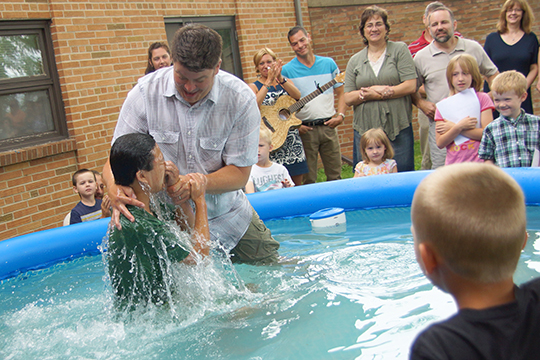 Zion has recognized the importance of investing in the lives of the young people and passionately wants to “pass the baton well” for the next generation. So, Zion is investing in meaningful and missional-focused ministries for children and youth. Zion has incorporated some of the concepts of “Sticky Faith,” and we are confident this impact will benefit the ministry of the Gospel of Christ for years to come.
Zion has recognized the importance of investing in the lives of the young people and passionately wants to “pass the baton well” for the next generation. So, Zion is investing in meaningful and missional-focused ministries for children and youth. Zion has incorporated some of the concepts of “Sticky Faith,” and we are confident this impact will benefit the ministry of the Gospel of Christ for years to come.
It has been important for Zion to continually think outside of ourselves. We have pushed ourselves to ask how we can make an impact in the world around us. A major part of the call of Zion is to share the Gospel to the lost and the hurting. We have recently partnered with the NWC and ECC in planting Renew Covenant Church in Eau Claire, WI, and have helped provide for ministry needs of Keuring Covenant Church in Ethiopia. We are continually learning what it means to be truly missional and to be used throughout the world for Jesus—starting in our own neighborhood!
Staying the course
Staying the course in the Vitality Pathway and being courageous in moving forward has allotted us the opportunity to plant a church, expand our missions impact, and create ministries within Zion that help us to achieve our mission and vision. So, next time you consider taking a drive and perhaps determine western Wisconsin is an ideal destination in your pursuit of beautiful scenery, pure maple syrup, and delicious cheese curds, consider Ellsworth, WI—a place with only one stop light, but also the home of Zion Covenant Church, a missional people, passionately pursuing Christ and His priorities in the world.
HOPE Church purchases Grand Forks mall where congregation has met for 20 years
By Stan Friedman, News and Online Editor for the Covenant Companion
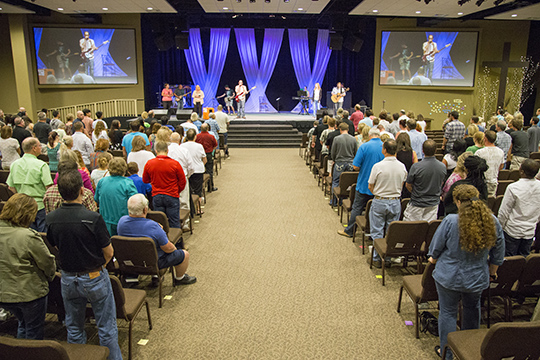 HOPE Evangelical Covenant Church recently purchased Grand Cities Mall, where it has met for nearly 20 years. The church had been negotiating to purchase extra space when current owners J. Herzog and Sons Inc. offered to let them buy the entire mall facility.
HOPE Evangelical Covenant Church recently purchased Grand Cities Mall, where it has met for nearly 20 years. The church had been negotiating to purchase extra space when current owners J. Herzog and Sons Inc. offered to let them buy the entire mall facility.
Hope launched in 1979 and moved to the mall in 1996. It purchased the space it currently occupies in 1998.
The church of about 1,000 people had explored the possibility of moving to another existing facility or constructing a new building but decided that purchasing the mall was the most economical alternative.
Kmart and Ace Hardware anchor the mall, but the indoor mall also includes a number of specialty shops and two other churches. HOPE will expand into spaces that currently are not occupied.
“In the fall we will open up a long dreamed of child-care center and preschool,” Knight said. “This is in direct response to a significant need in our community. Our church staff has been without ‘official’ offices for about five years, and our adult education and equipping ministries have been out of space for quite some time as well.”
Long-term vision
Knight said the church has long-range dreams for the property. “Someday, we hope to create this mall property—27 acres—into a space that draws the community. We are imagining things like park space, walkways, senior adult housing, new retail spaces, a larger worship center, a spiritual life and leadership training center. Many of these dreams will be shaped in the future, but what we do know is that God has opened a door for us to pursue our vision of ‘touching with the hope and love of Jesus Christ at least 10 percent of the unchurched people in the Greater Grand Forks area.’”
There are no plans in the near future to take over any of the occupied space. Knight told the Grand Folks Herald that a separate limited liability company has been formed to oversee the mall, so the part of the building that is not a church will not be tax-exempt, and current mall management will stay in place for now.
“The goal really isn’t to be mall managers, the goal is to be a church,” Knight said.
Discussions had been ongoing for a long time. “It was at Midwinter in 2014, during the message by Wilfredo De Jesus, that I went forward at the altar call and committed to keep walking the path toward purchasing the mall for as long as the door was kept open,” Knight said. “Just over a year later we have congregational agreement to purchase the property.”
National Covenant Properties financed the deal.
“National Covenant Properties has been amazing in the way they have guided us, supported us and facilitated throughout this process,” Knight said. “There were many days that we thought that this was not going to come together, and God has clearly positioned the right people at the right time to keep us on the path.”
Good Shepherd’s Manna Market has rescued, redistributed 2.25 million pounds of food
By Hollis Kim, Lead Pastor, Good Shepherd Covenant Church
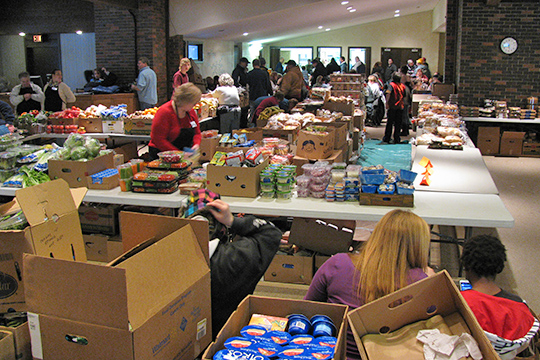 Imagine 12,000 pounds of fresh produce, meat, dairy and bakery products dumped into landfill because it was close to or had just expired at your local supermarket. What a waste! Now, imagine a small Covenant church converting its sanctuary and fellowship hall into a “market” where guests can select from those six tons of food. Since 2010, Good Shepherd Covenant Church’s Manna Market in Blaine has rescued and redistributed just over 2.25 million pounds of food to our surrounding community.
Imagine 12,000 pounds of fresh produce, meat, dairy and bakery products dumped into landfill because it was close to or had just expired at your local supermarket. What a waste! Now, imagine a small Covenant church converting its sanctuary and fellowship hall into a “market” where guests can select from those six tons of food. Since 2010, Good Shepherd Covenant Church’s Manna Market in Blaine has rescued and redistributed just over 2.25 million pounds of food to our surrounding community.
Each week, 90 or more volunteers contribute to making this happen. The transformation begins Wednesday night, when pews are moved aside; Thursday, tarps and tables, coolers and crates are set up to create the marketplace. Early Friday morning, the first of two trucks from Second Harvest Heartland are unloaded, and volunteers arrive to begin the considerable task of sorting food, readying it for that night’s distribution.
Young and old, teens and retirees, folks from Good Shepherd and beyond, even current and former guests, work alongside each other to pull off this large, labor-intensive operation. Many of our church’s senior citizens really love this ministry because of the fellowship of working together to serve families who are struggling to put food on the table.
It started in 2009 when the Lord asked me, “Son, what are you doing to serve the poor?” I had no answer. We began by gathering and giving away leftover food from the local middle school cafeteria. Another area church had a Manna Market, so we checked it out and after several weeks of due diligence, communal prayer and discernment, we sensed God leading us to start one at Good Shepherd. With helpful mentoring from veteran practitioners, we learned on the fly and have never looked back. We now collect leftover food from five school cafeterias, as well as from area restaurants. Some of this is distributed; most is used to serve our guests a hot meal before the evening distribution begins.
God didn’t stop with us. At a revitalization pastors gathering, I shared what we were doing and invited Mark Ellingson, pastor at Fridley Covenant Church in Fridley, MN, to come and see. Shortly thereafter, Fridley Covenant started its own Manna Market. Folks from Trinity Lutheran Church in St. Francis, MN, heard about us, sending a team to investigate. Sensing God’s call to start one there, they spent six months apprenticing, learning the “big picture” and the operational logistics, and launching their own market in 2012. A small Andover church partnered with a local food shelf to start Manna Market there. All told, six churches’ Manna Markets currently serve their respective areas with hopes to grow more.
God is using Manna Market to forge and polish the character of Jesus in us. Working so hard and so closely together uncovers our character flaws and stresses relationships. God’s provided plenty of opportunity to practice loving and forgiving one another! It’s given us fresh vision for mission and service together, putting feet on the faith we celebrate on Sunday mornings.
Manna Market has opened our eyes to who our neighbors are, people previously “invisible” to us: the chronic and situationally poor, those struggling financially, physically, emotionally/mentally, relationally and spiritually. We hear stories of our guests’ pending evictions, some living in their car; folks ask us to pray for children or grandchildren facing court dates or jail time, drug/alcohol addictions, cancer and death. The world has come to us, as some of our guests are Ukrainian and Russian, Ethiopian, Somali, Iraqi, Thai, Vietnamese, Hmong, Mexican, Central and South American, Congolese. We’ve been learning anew Jesus’ command to “love your neighbor as yourself.”
God speaks to us through Isaiah 58:6-8: “Is not this the kind of fasting I have chosen: to loose the chains of injustice and untie the cords of the yoke, to set the oppressed free and break every yoke? Is it not to share your food with the hungry and to provide the poor wanderer with shelter—when you see the naked, to clothe them, and not to turn away from your own flesh and blood? Then your light will break forth like the dawn, and your healing will quickly appear; then your righteousness will go before you and the glory of the Lord will be your rear guard. Then you will call, and the Lord will answer; you will cry for help, and he will say: Here am I.”
It’s easier to experience than to explain Manna Market. To volunteer or bring a group to serve, contact Bonnie Randall at 612-229-6296 or gsblaineoffice@gmail.com.
Hope Covenant in St. Cloud experiencing vitality through outreach to international students
By Keith Meyer, Lead Pastor, Hope Covenant Church
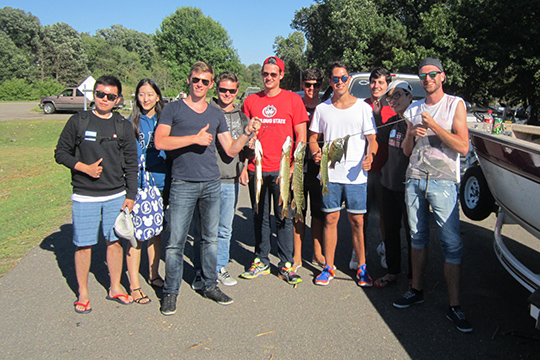 Reenu was one of 120 St. Cloud State University international students served lunch at Hope Covenant’s first partnership with the University’s International Studies Center in August 2014. Our site is right next to the campus, the heart of downtown St. Cloud, MN. She is one of many international students who are revitalizing our church and helping us discern a new vision for Hope Covenant.
Reenu was one of 120 St. Cloud State University international students served lunch at Hope Covenant’s first partnership with the University’s International Studies Center in August 2014. Our site is right next to the campus, the heart of downtown St. Cloud, MN. She is one of many international students who are revitalizing our church and helping us discern a new vision for Hope Covenant.
At one time we had a ministry to college students, but that had dried up as the church’s mission started to atrophy due to ongoing inner conflict. Churches in decline, like ours was, slowly turn inward as they become self-absorbed and lose energy for organizational mission.
So we started the Vitality Pathway in 2011, discerned with our Vitality Team and the Pulse Survey what growth areas to work on, and plans were put into play for improving worship and developing missional focus. Soon the downward spiral toward “At Risk” from “Critical Moment” was arrested, and we went on to “Stable” and are now tasting what it means to be “Healthy Missional.”
The ministry to international students was a no brainer with SCSU staff in our church, and a strong college ministry presence at SCSU from a nearby sister congregation, Grace Covenant Church of Little Falls, MN, with whom we could partner and not start from scratch. The lunches have energized our people outward as a first and doable mission project. At that first lunch, a couple table hosts brought me a student with a question about our church, one curiously named Reenu. She asked, “So, what kind of church is Hope?”
After quickly deciding not to share in detail the six affirmations of the Evangelical Covenant Church, I explained, “We are just followers of Jesus here”—a shortened form of our new but rough draft vision statement: “Following Jesus from wherever we are, Experiencing God’s belovedness of us, Sharing our lives with the last, least and the lost.
Reenu, a Buddhist Graduate student in gerontology from Kahtmandu, Nepal, said, “That’s what I want!” Reenu is now regularly worshipping with us, has been invited into our homes and is even participating in Hope’s mission as she follows Jesus from where she is at now.
Wanting to sign up as a greeter for our second orientation lunch in January, a Hope leader said to her, “Reenu, you don’t have to sign up, the lunch is for you … the international students.” Reenu then explained she wanted to help as part of our team in reaching students—she had become one of us. Impacted by a series on Mark and Jesus’ question, “Who do you say that I am?”, Reenu has started reading Scripture and initiated a ministry project to the homeless in the area.
Reenu is a sign of the Spirit’s renewal being out ahead of us in the people we meet and our need to simply join God as he works in their lives. And we are thankful to the ECC and Northwest Conference for the Congregational Vitality process and its part in bringing revived ministry to Hope Covenant. We are learning from Jesus what it means to simply call for people to follow Him and watch them begin to belong, and then to believe.
90-year-old Bethlehem Covenant completes vitality pathway, experiences growth and new ministry
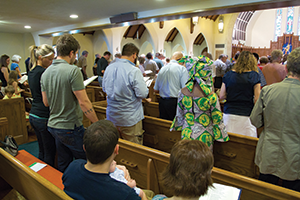 Bethlehem Covenant Church in Minneapolis traces its earliest roots back to a South Minneapolis home, where in 1913 a Sunday school for children studying at Minnehaha Academy was started. On December 28, 1922, Bethlehem Covenant Church was organized with 26 charter members. The facilities of Minnehaha’s school chapel and classrooms were made available to the new church.
Bethlehem Covenant Church in Minneapolis traces its earliest roots back to a South Minneapolis home, where in 1913 a Sunday school for children studying at Minnehaha Academy was started. On December 28, 1922, Bethlehem Covenant Church was organized with 26 charter members. The facilities of Minnehaha’s school chapel and classrooms were made available to the new church.
Fast forward 90 years, and Bethlehem is now the first church in the Northwest Conference to complete the Vitality Pathway and develop a resulting Strategic Ministry Plan.
Each church that has engaged elements of the Vitality Pathway has a unique story to tell. BCC’s journey began in 2008 when the church was in the midst of a pastoral search process. Delegates to the NWC Annual Meeting heard about Veritas from John Wenrich, director of congregational vitality for the Evangelical Covenant Church.
Leaders from the church were excited about the potential impact of Veritas at BCC, but decided not to proceed with the process until a new pastor was called.
Pastor Ryan Eikenbary-Barber was installed on Sept. 20, 2009, and one year later, on Sept. 25, 2010, 60 members of BCC participated in a Veritas seminar led by Mark Stromberg, current NWC superintendent.
“There was an excitement generated that day that can only be explained by the Holy Spirit at work in the congregation,” said Charlotte Sjoberg, president of BCC.
Veritas helped build momentum for the church to form a Vitality Team, and one month later, potential leaders for that team were being identified. Leaders from Bethlehem were also invited to participate in the first Navigate meetings in Kansas City, and out of that experience, Bethlehem was paired with two other NWC churches on the Vitality Pathway: Edina Covenant Church and Rice Creek Covenant Church.
In January 2011, BCC’s Vitality Team held its first meeting, and by March 2011, church leadership was participating in an EPIC workshop, also facilitated by Stromberg. To keep the congregation informed, the Vitality Team developed a month-long devotional series based on the 10 Healthy Missional Markers.
“A lot of effort has gone into keeping the congregation informed about the process and outcomes,” Sjoberg said. “It has been very
rewarding to hear people outside those directly involved in the process talking about becoming a more healthy missional church.”
On May 15, 2011, the congregation took the PULSE Survey during its worship service. Seventy-eight percent of those who responded were positive toward starting a second, more contemporary worship service. BCC’s Vitality Team spent the summer studying the demographics of the church’s neighborhood using MissionInsite, a tool provided by the NWC to all its constituent churches.
In the fall of 2011, church leaders attended “ONE: A Unified Approach to Strategic Planning,” a presentation by Wenrich and NWC staff designed to help facilitate the planning process. BCC leaders decided to break down the job of developing the Strategic Plan into “bite size tasks” and set a goal of completing the plan by May 31.
“We started putting up ‘Post it’ flip charts [in the room] where we held our meetings that summarized the main points of our meetings so the congregation could follow our progress and give us input, if they had questions or ideas,” explained Lowery J. Smith, BCC’s vitality chairperson.
“We were a stable congregation and it was easy to think there was no need to change anything. After a realistic evaluation of where our congregation was moving, I believe we have taken strides toward becoming a healthy missional church,” Sjoberg said.
The Strategic Planning team developed a Mission Statement, Vision Statement and a set of Core Values. From there, the team also created Critical Success Factors, and a first draft of the Strategic Plan. After a second draft, the planning team presented the Strategic Plan to the Church Council on May 17 and it was approved.
“We have committed ourselves to studying the Bible more. We are seeking to take more risks and leaps of faith,” Eikenbary-Barber said. “Bethlehem is developing a series of small groups to enhance fellowship and discipleship, study God’s Word, and serve others in need.”
“We pray that the final Strategic Plan will not sit on a shelf and gather dust, but can be updated and modified on a regular basis as conditions and priorities change,” Smith said.
“The Vitality Pathway invited us to go exploring our own uncharted territory. It gave us the freedom to step away from stability towards health and vitality,” Eikenbary-Barber said. “There is a profound sense that the Holy Spirit is moving in new ways at Bethlehem Covenant Church.”
Vitality Pathway testimony from LaBolt, SD
Redeemer Covenant uses soccer—and an unused field—to reach out to its community
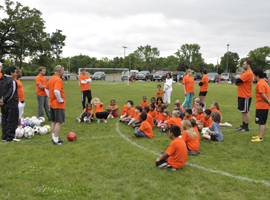 “A mission field in our own backyard” took on a literal meaning when Redeemer Covenant Church in Brooklyn Park, MN, turned its seldom-used softball diamond into a popular soccer field last summer.
“A mission field in our own backyard” took on a literal meaning when Redeemer Covenant Church in Brooklyn Park, MN, turned its seldom-used softball diamond into a popular soccer field last summer.
Brooklyn Park, a second-ring suburb of Minneapolis, has an increasingly multicultural population of nearly 76,000. Soccer is a common denominator among the varied ethnicities represented in the area. A deep desire to reach outside church walls and meet their neighbors led the church to host its first soccer camp for local children and their families last summer (with an improved program offered again this season).
The origins of the camp actually go back a couple years. At that time, Redeemer’s pastor Steve Larson had already been praying for opportunities to reach out to the growing population of Latino families in the community. A new Spanish-speaking Covenant church plant, La Bendición, eventually started meeting at Redeemer, a location that was central to where many Latino families live and work. Both congregations have flourished through opportunities to share worship and fellowship, serve together in the community, and reach out in the name of Christ.
La Bendición’s pastor, Juan Lopez, recognized the possibilities of creating a soccer program both as an outreach to the neighborhood children and as a way to involve families within his own congregation. Lopez knew that church attender Santos Gonzalez had been a professional soccer player in Ecuador, so he shared his idea with Gonzalez for inviting neighborhood children to come play soccer at Redeemer’s field. Gonzalez became excited by the idea and volunteered to be one of the coaches.
Conversation ensued regarding a joint summer soccer camp. Some members of the Redeemer congregation had been suggesting for a few years that the church purchase soccer goals and set them up on the unused softball field. The idea began to take hold among both congregations, and they prayed together for God’s blessing.
Creating a program
Plans for the program quickly fell into place. Kickin’ Kids Soccer Camp would be offered on Tuesday and Thursday evenings from mid-June through mid-August. It would be free and available to kids between the ages of 6 and 15.
Four coaches—two from each congregation—volunteered to lead the camp. From La Bendición came Gonzalez and Lopez, who had learned to play soccer in his native Colombia. And from Redeemer were Kenny Oyederu, a certified soccer coach who came to America from Nigeria 16 years ago, and Keith Weiman, a longtime member of the church who had played soccer as a child in the United States.
Support from the two congregations was strong. Within two Sundays, they gave enough money for the goals, nets and field-marking equipment.
The next step was to get the word out to the neighborhood. The churches created brochures in English and Spanish, which they passed out door-to-door and mailed to children who had previously attended church programs.
On the first evening of the camp, volunteers had taken care of all the details. The coaching staff set up goals, and the facilities staff marked the white game lines. Balls were inflated to the right pressure, and the water jug was filled and perched on the coach’s pickup tailgate with plastic cups ready for water breaks. Information sheets and registration forms were available in both English and Spanish, and the first aid kit was handy.
Everything was prepared. The field was ready. Would anyone come?
When 20 children showed up, the staff was thrilled. Through word of mouth, attendance more than doubled after that, with about 50 children on the field each successive session. By the end of the summer, the roster listed the names of 85 soccer players.
Each session of camp started with prayer and a short devotional. The kids were divided into two groups—6- to 10-year-olds in one group, and 11- to 15-year-olds in the other. They practiced soccer basics, concentrating on just a few skills at a time. Sometimes they divided into teams to scrimmage, but no score keeping was allowed.
Campers also learned to get along with each other. “After each clinic we would think of a word like love or respect and ask the kids what that word meant to them,” says Weiman. Such dialogue gave the coaching staff a chance to emphasize the character qualities of good sportsmanship.
Hosting on the Sidelines
Much more happened in the soccer camp than kicking, dribbling and passing the ball on the field. While the coaches and assistants concentrated on the players, hospitality team members connected with parents and family members on the sidelines. They warmly greeted everyone, registered new children, provided water, and directed individuals to a portable restroom that was wheelchair accessible.
The hospitality team passed out information about upcoming vacation Bible school, AWANA, and children’s events offered by Redeemer and La Bendición throughout the rest of the year. Most of the material was published in both English and Spanish.
Enhancing the future
This summer the church has expanded the camp to include 3- to 5-year-olds for a half-hour at the beginning of each evening of camp. Age-group levels meet consecutively rather than all at once to relieve the congestion on the field. A regular 15-minute devotional tailored for each age group is incorporated into the evening’s schedule.
For this summer’s session, rosters filled up completely in the two younger age groups after one week of registration, and soon there was a waiting list for the 10- to 15-year-olds as well. Most exciting was the fact that two-thirds of the 100 participants this summer do not attend either Redeemer or La Bendición.
This year a small fee for the camp was required ($10 per child or $25 per family). The church recognized that players are more committed to consistent attendance if the family has invested something in the program. With the registration fee, each player received a team t-shirt.
“Redeemer Covenant Church is striving to be a community learning compassion and worship that is centered on Christ,” said Pastor Larson. “The joint soccer program with La Bendición created an appreciation between the congregations as we began to learn more about each other. Through the strength of our work together, we compassionately engaged the community that is so close to our door.”
Jesus says in John 13:35, “By this everyone will know that you are my disciples, if you love one another.” With that in mind, Redeemer and La Bendición seek to be places of light and warmth in a difficult world, providing fun along the way through ministries like Kickin’ Kids Soccer Camp.
Adapted from the article that appeared in the August 2011 issue of the Covenant Companion.
First Covenant St. Paul’s partnership with Farnsworth grows
 Farnsworth Aerospace Elementary is a public school across the street from First Covenant Church on the East Side of St. Paul. For many years, students from the school participated in the Religious Release Program offered at First Covenant. In 2006, Dr. Vincent, principal of the school, agreed to have those students participate in a Christmas musical, which was presented both at the church and the school.
Farnsworth Aerospace Elementary is a public school across the street from First Covenant Church on the East Side of St. Paul. For many years, students from the school participated in the Religious Release Program offered at First Covenant. In 2006, Dr. Vincent, principal of the school, agreed to have those students participate in a Christmas musical, which was presented both at the church and the school.
Two years later, Dr. Vincent became the principal of Cleveland Middle School, in addition to Farnsworth Elementary. The middle school had struggled for the past 5 years with low results from standardized testing and was on the “No Child Left Behind” list as a result. It was clear the school needed transformation.
In 2009, the Christmas musical “Just Believe” played a part in that transformation, with students from both Farnsworth and Cleveland schools participating with children from the church. All performances were held at the Cleveland auditorium and Sunday worship was moved there as well for a special performance.
With each production, the level of participation of students increased and the expectations grew higher. This year the Ministry Team and Lay Leadership sought to engage more of the congregation in the whole process, with the goal of building relationships with the community. A large team of drivers provided transportation while others provided food for all rehearsals. A Prayer Team was praying for the whole production and for each participant by name, as the congregation was challenged in worship through adult spiritual growth opportunities to “become missional friends,” the theme for Lent. Even though there were many obstacles and difficult challenges along the way, the spring production of “Joseph and the Amazing Technicolor Dreamcoat” came together in a miraculous way.
“As a result of the relationships formed with the Farnsworth students, many are participating in the Wednesday night program and some are even bringing their parents,” said Richard Voth, Minister of Worship & Creative Arts at First Covenant Church of St. Paul. “Forty percent of the cast from Farnsworth have signed up to go for the first time to Covenant Pines Bible Camp this summer. God is at work!”
The Gallery joins with local grade school
One of the Northwest Conference’s newest churches, The Gallery Covenant Church in St. Paul, has begun a relationship with the Barack and Michelle Obama Service Learning Center, a grade school in the church’s neighborhood. The Gallery has made a bold commitment to move 35 percent of its offerings outside its doors to serve its local community. The largest part of this giving will be going to the Obama school.
Pastor Brad Kindall, the son of public school teachers, felt early on a financial and people-power investment in one of the local schools would be one of the best ways to let the local community know his new church was there to serve. The Gallery’s first investment will be purchasing what is called a Peaceful Playground for the Obama school. The school had applied for a grant to purchase the playground, but was disappointed to see the funding fall through. Principal Lori Simon told Pastor Kindall the teachers were “jumping up and down” when they heard The Gallery had stepped in to help.
In addition, The Gallery community will be investing volunteer hours tutoring students in reading, serving at evening school events, gardening with the second grade classes, and providing monthly treats for the faculty and staff.
“Over 90 percent of the students at this school are living at or below the poverty line. We feel honored to be able to serve Jesus in this way,” Kindall said. “Five years from now, just imagine the stories we’ll be able to tell of God’s handiwork!”
Prairieview Covenant Church sends bears to Haiti
Six-year-old Josh Mottl was watching the news about Haiti’s earthquake in January when he felt very strongly that children in Haiti needed stuffed animals to comfort them. He stood up in Prairieview Covenant Church in New Richmond, WI, two weeks in a row and told of his project and asked people to help.
Josh and his family could never have imagined what would come from that request for the church people to help him. The New Richmond News came to his house and interviewed him for a front-page article in mid February. He collected 530 animals and had calls from as far away as Barron and Ladysmith, WI, for donations.
At Midwinter, Nancy King, wife of Prairieview pastor Rudy King, went to the World Relief meeting on Haiti and was able to connect with the Rev. Ed Carey of Kingdom Covenant Ministries, in Miami, FL. They have many Haitians in their congregation and they are able to get things to the people of Haiti. Volunteers from Prairieview mailed 12 large boxes of animals to Miami in early March. It has been fun to see what God can do with a small child’s dream.
Zion Covenant hosts baseball bat giveaway
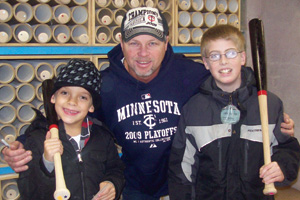 On Dec. 24, 2009, Zion Covenant Church joined forces with Rally Sporting to give away 120 personalized baseball bats to kids who might not otherwise have received a Christmas gift. The giveaway was the idea of Randy Hartl, who owns Rally Sporting with his wife Anita. Randy’s co-worker, Lowell Peterson, is a member of Zion Covenant Church and led the effort to raise funds to support the initiative.
On Dec. 24, 2009, Zion Covenant Church joined forces with Rally Sporting to give away 120 personalized baseball bats to kids who might not otherwise have received a Christmas gift. The giveaway was the idea of Randy Hartl, who owns Rally Sporting with his wife Anita. Randy’s co-worker, Lowell Peterson, is a member of Zion Covenant Church and led the effort to raise funds to support the initiative.
Each child was given a tour of the plant where the bats are made and then invited to sign their names to be laser inscribed on their bat. The highlight of the event was the presence of Minnesota Twins batting coach Joe Vavra, a childhood friend of Randy Hartl’s. Joe was available for pictures and conversation and distributed some bats at Children’s Hospital on Christmas Day. Plans are underway to repeat the giveaway this Christmas.
First Covenant Church in Willmar, MN, opens its doors
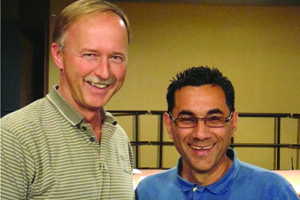 Situated about 2 hours west of the Twin Cities, First Covenant Church in Willmar, MN, is also seeing its ministry context shift. According to the U.S. Census Bureau, Kandiyohi County is 9.7 percent “persons of Hispanic or Latino origin,” compared with a statewide average of 4.1 percent. The city of Willmar itself is closer to 15 percent Hispanic or Latino. First Covenant Church in Willmar is at the beginning of considering God’s will for Hispanic ministry within the congregation. One year ago, the congregation became aware of a Hispanic church called Templo Mahanaim Asamblea de Dios that desperately needed a place to meet.
Situated about 2 hours west of the Twin Cities, First Covenant Church in Willmar, MN, is also seeing its ministry context shift. According to the U.S. Census Bureau, Kandiyohi County is 9.7 percent “persons of Hispanic or Latino origin,” compared with a statewide average of 4.1 percent. The city of Willmar itself is closer to 15 percent Hispanic or Latino. First Covenant Church in Willmar is at the beginning of considering God’s will for Hispanic ministry within the congregation. One year ago, the congregation became aware of a Hispanic church called Templo Mahanaim Asamblea de Dios that desperately needed a place to meet.
“Where they were meeting they had no heat and the temperature in the building was in the 30s,” said Dan Johnson, senior pastor of the church. First Covenant leaders met with the Hispanic church’s pastor and wife, Hector and Sara Pinochette, and worked out a free facility sharing deal. “We just wanted to help them out until they could get their feet underneath them,” Johnson said.
Over the past year, the two congregations have begun to interact through shared meals, a few joint services, and collaboration during a summer outdoor service. Johnson has also formed a close friendship with Pastor Pinochette. “The benefits for us have been subtle, but powerful. We have had the opportunity to extend grace and love to our Hispanic brothers and sisters and to rub shoulders with them,” Johnson said. “Hispanic ministry now has a face and names and is up close and personal, whereas before it was simply a people group. That reality, in and of itself, is huge.”
Johnson hopes that bridging the cultural divide between congregations will only continue as church leadership considers the future of Hispanic ministry at First Covenant in Willmar. “I think God has been preparing us for Hispanic ministry in our community through this relationship with Mahanaim that otherwise would not have happened,” Johnson said. “We continue to pray and seek God’s leading.”
